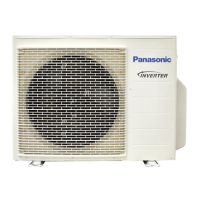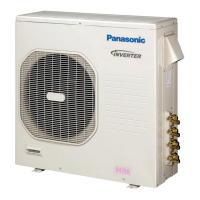Why is the TIMER indicator always on in my Panasonic Air Conditioner?
- OostrongSep 1, 2025
The TIMER indicator is always on in your Panasonic Air Conditioner because the timer setting repeats daily once it has been set.

Why is the TIMER indicator always on in my Panasonic Air Conditioner?
The TIMER indicator is always on in your Panasonic Air Conditioner because the timer setting repeats daily once it has been set.
Why is my Panasonic Air Conditioner outdoor unit emitting water or steam?
The emission of water or steam from your Panasonic Air Conditioner's outdoor unit is due to condensation or evaporation occurring on the pipes.
What to do if my Panasonic CU-3S27MKZ Air Conditioner doesn't receive the signal from the remote control?
If your Panasonic Air Conditioner isn't responding to the remote control, first, ensure that the receiver on the unit is not obstructed. Note that certain fluorescent lights may interfere with the signal transmitter; please consult authorised dealer.
Why does my Panasonic Air Conditioner remote control not work?
If your Panasonic Air Conditioner remote control isn't working, ensure the batteries are inserted correctly. If the display is dim or the signal is weak, try replacing the batteries with new ones.
How to improve the efficiency of COOL mode on my Panasonic CU-3S27MKZ?
If the COOL mode on your Panasonic Air Conditioner isn't working efficiently, make sure you've set the temperature correctly. Also, ensure all doors and windows are closed to keep the cool air in and clean or replace the filters. Finally, check that there are no obstructions blocking the air inlet and outlet vents.
Why Panasonic CU-3S27MKZ unit does not work?
If your Panasonic Air Conditioner unit isn't working, check the following: * Make sure the circuit breaker hasn't tripped. * Check if any timers have been set that might be preventing it from turning on.
How to clean dust around my Panasonic CU-3S27MKZ?
Dust accumulation around the front panel, grilles, and wall surrounding the unit after extended use is due to the air purification effect of negative ions. To resolve this, regularly remove the dust with a clean, dampened cloth.
| Cooling Capacity (BTU) | 27000 |
|---|---|
| Cooling Capacity (kW) | 7.9 |
| Power Supply | 220-240V, 50Hz |
| Refrigerant | R32 |
| Outdoor Unit Weight | 55 kg |
| Noise Level (Indoor) | 42 dB |
| Type | Split System |
Details how ECONAVI detects energy waste and adjusts cooling power.
Explains how nanoe-G deactivates micro-organisms and keeps the unit clean.
Describes the operation of indoor units in a multi-split system.
Instructions on how to insert batteries into the remote control.
Steps to set the clock on the remote control.
Guide to basic operation: mode selection, start/stop, and temperature setting.
Safety warnings related to the indoor and outdoor units.
Safety warnings specific to the remote control.
Precautions regarding the power supply cord and connection.
Details on using ECONAVI for optimized energy saving.
Guide to choosing AUTO, COOL, or DRY operation modes.
Instructions for using SLEEP mode for better sleeping comfort.
How to switch between POWERFUL and QUIET modes.
Using the Auto OFF/ON button when the remote is lost.
Explanation of nanoe-G's function to purify air and deactivate microbes.
How to adjust fan speed using the remote control.
How to adjust air swing direction with the remote.
Instructions for setting ON and OFF timers.
Functionality of auto restart after power failure.
Detailed explanation of AUTO, COOL, and DRY operating modes.
Details on nanoe-G's deactivation process after unit shutdown.
How ECONAVI uses human activity and sunlight sensors to save energy.
Describes the detection area and performance of the human activity sensor.
Specifies the recommended operating temperature ranges for indoor and outdoor units.
How to clean the indoor unit, front panel, and sensors.
Instructions for cleaning air filters and the nanoe-G generator.
Steps for removing and attaching air filters.
Checks to perform before storing the unit for a long period.
Lists common operational symptoms and their likely causes.
Checks to perform before calling for service.
How to retrieve error codes using the remote control.
Guidance on discarding items outside the European Union.
Explanation of the battery symbol and its potential combination with chemical symbols.












